The experimental X-15 carried the first human into the weightless realm above. Devoid of the oxygen essential to life, space is defined as beginning at an altitude of 62 miles. Many of the 199 missions (each was brief) penetrated the inky black boundary of outer space. Eight of the dozen X-15 pilots were ultimately awarded astronaut wings. It was enough to make the fictional pulp fiction hero Buck Rogers swoon. In fact, Neil Armstrong, the first person to set foot on the moon, was an X-15 pilot. Unlike the later Mercury or Gemini space capsules, the X-15 was an airplane that demanded a skilled pilot at the controls.
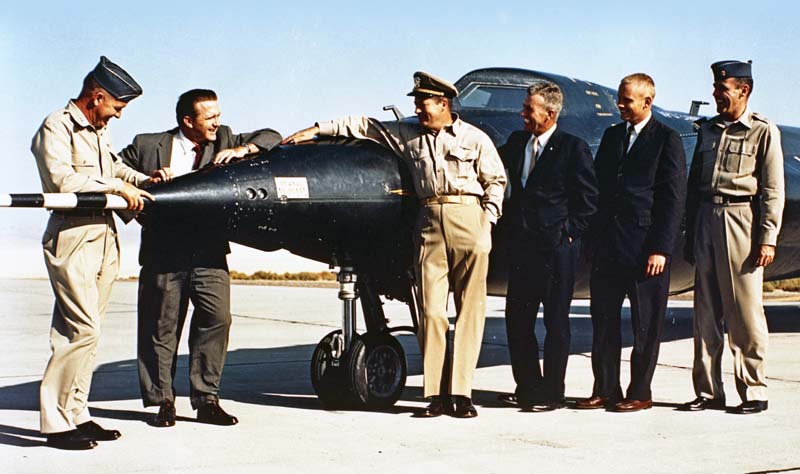
A dozen of America’s finest civilian and military engineering test pilots were trained to take the X-15 aloft from Edwards AFB, California. They represented the U.S. Air Force, Navy, NASA, and North American Aviation, Inc., the prime contractor. (Photo courtesy of Boeing Archives)
During the 1950s, North American Aviation, Inc. (NAA) was arguably the world’s premier aerospace company after having built a record 40,000 warplanes (including the B-25 and P-51) for World War II and thousands more Cold War era swept-wing jet fighters, including F-86 and F-100. NAA prospered by seizing upon, embracing, and then enhancing the embryonic Nazi technologies of rockets, swept wings, jet engines, and primitive guidance systems. These were bundled and then leveraged to provide NAA a competitive advantage.
The entire X-15 production run comprised a mere three units; however, this iconic research vehicle became an important stepping-stone to the moon landing. The X-15 epitomized small and fast by setting unofficial records of speed (4,520 mph) and altitude (354,200 feet), which remain formidable today. (They are unofficial because the X-15 dropped from a Boeing B-52 mothership already at 45,000 feet altitude rather than departing the ground under its own power.)
Some have forgotten that by the mid-1950s, American youngsters knew space to be an adventuresome frontier while their parents may have feared it would become the next Cold War battleground. Both views had credence.
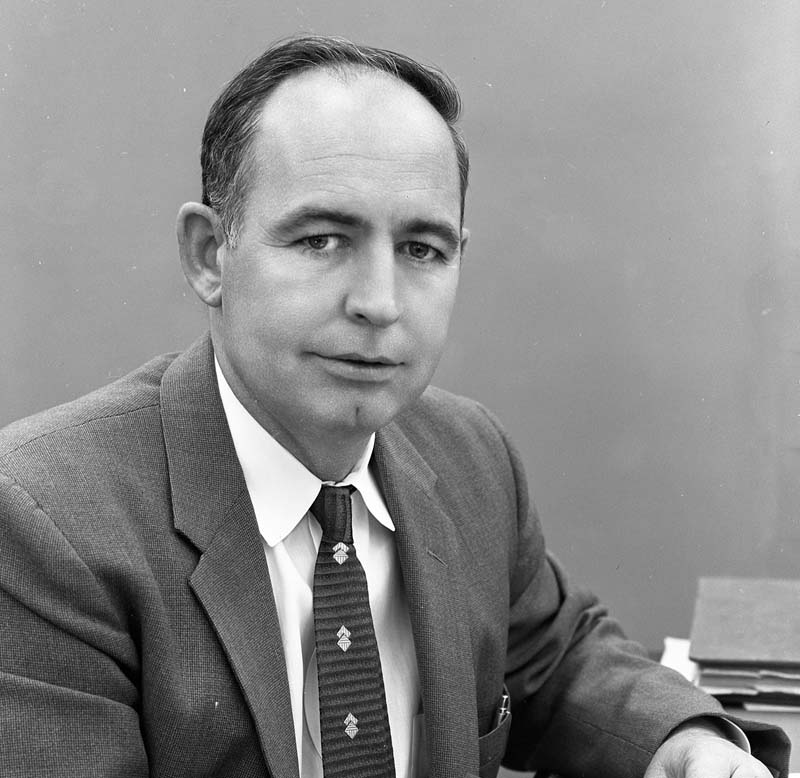
Charlie Feltz (1916-2003) was a plain-spoken Texan and one of the key designers behind the X-15. He earned himself fame as chief engineer on subsequent projects including Apollo and Space Shuttle. (Photo courtesy of Boeing Archives)
Genesis of a rocketship
Between June 1952 and July 1954, a committee called NACA (the predecessor to NASA) reviewed the needs for a unique airplane that would probe the boundaries of outer space. The requirements were gathered for bid into a lengthy proposal known as Project 1226. The goal was to gain a better understanding of the aerodynamics associated with departing and reentering Earth’s atmosphere with a human aboard. The specification was to reach 250,000 feet and to fly at Mach 6.6.
The invitation for proposals went to several aircraft companies. On January 18, 1955 representatives from Bell Aviation, Boeing, Chance Vought, Convair, Douglas, McDonnell, NAA, Northrop, and Republic met with the government contracting officers from Air Force, Navy, and NACA to discuss the competition and design stipulations. A separate meeting was held with propulsion manufacturers: Aerojet, General Electric, NAA Rocketdyne, and Reaction Motors. Air-breathing jet engines would not work beyond Earth’s atmosphere. Rocket power was needed.
After months of proposal reviews, it became evident that North American Aviation of Los Angeles was the leading airframe contender. The contract was awarded in December 1955. The three aircraft were assigned Air Force serial numbers. Reaction Motors provided the propulsion system. An X-plane contract bestows upon the winner extensive press coverage, immediate access to newly discovered manufacturing breakthroughs, and important follow-on opportunities. Furthermore, the X-15, with a flight trajectory traversing the boundaries of outer space, would generate world-wide interest.
Two million hours of engineering
Seasoned NAA aircraft engineers Charlie Feltz, Bud Benner, and Ron Robinson were placed in charge of the program. Directly assisting was an experienced NACA test pilot, Scott Crossfield. His early participation in the program, along with the other NAA test pilots assigned to the project, led to major improvements in the X-15 human factors design envelope. Keeping a human alive into outer space required expense and ingenuity. Unlike the space capsules that followed (e.g. Mercury, Gemini, and Apollo) the X-15 was an aircraft that demanded a pilot to fly it. In some ways, a miniature precursor to the Space Shuttle which ultimately replaced the space capsules.
It was Scott Crossfield, for instance, who held out for the full pressure space suit. The Air Force thought their simpler (and cheaper) partial pressure suit would suffice. After debate, the capability evolved to include full pressure suit, and means to keep it temperature regulated. The next was about pilot emergency escape. The Air Force advocated an escape capsule as was installed in the B-58. It fell from favor when it was determined air vehicle weight would increase by 9,000 pounds. With Crossfield’s blessing, an enhanced ejection seat became the compromise. The ejection window was between 90 knots to Mach 4 and at any altitude up to 120,000 feet. The pilot remained with the seat to 15,000 feet (or three seconds, if below 15,000 feet).
The X-15 is a comparatively small airplane being 50-feet long and with a 22-foot wingspan. Although conventional in general configuration, it has an unusual wedge-shaped vertical tail and thin stubby wings. Unique side fairings that extend along the fuselage house propellant and hydraulic lines. The thick tail, with its blunt leading edge that broadens like a piece of pie at the rear, is designed to provide directional stability at high speeds. Extending above and below the fuselage, it contains speed brakes that pop out to slow the airplane down during reentry. The lower portion of the tail, called a “ventral,” is jettisoned before landing so that it won’t strike the ground as the airplane settles on its skids, which are just under the tail. It has conventional twin nose wheels.
The cockpit, located far forward, is comparable in size to that of any jet fighter. The clamshell canopy that fits snugly just above the head of the pilot has narrow panels with double glass layers on either side. Both pitch and roll are controlled by the horizontal stabilizer. The airplane has no ailerons, although flaps are located on the inboard trailing edges of the wings.
To fly faster than any other aircraft, the X-15 had to be configured to solve the stability problems of high Mach flight. As the Mach number increases, the airflow becomes increasingly affected by the powerful shock waves produced by the passage of the plane. In hypersonic flight, usually above Mach 4, shocks will dominate the airflow and dramatically reduce the lifting ability of the wings and tail. The instability can be so degrading to the aerodynamics of the vertical fins that they can no longer overcome the aerodynamic instability of the fuselage.
The designers countered this instability in two ways. The airplane had very large upper and lower vertical fins with a downward slant of the wings. The fin area was 60 percent that of the wings. The fins also had a wedge cross-section with a broad, flat, chopped-off trailing edge. The thick fuselage side strakes that contained the fuel tanks were also chopped. At hypersonic speed, the body and strakes provided most of the lift because of the effect of shocks on the lifting ability of the wings. At subsonic speed, the wings carried most of the load.
Two million engineering hours of labor were expended on X-15. Four thousand hours of testing was accomplished at thirteen different wind tunnels. Temperature extremes—extremely high and extremely low—and occurring almost simultaneously in various sections of the airframe, dictated the choice of metals to be used.

Given the risky and experimental nature of the endeavor, this 1966 graphic documents the X-15 program to be operationally reliable.
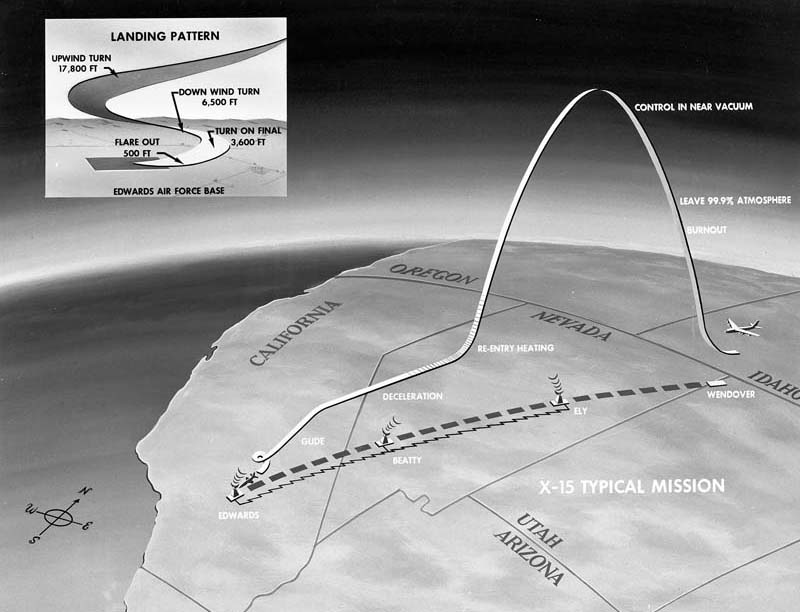
The typical mission profile for an X-15 launch started with the B-52 gaining altitude on its way to Wendover. It then reversed course back towards Edwards AFB. Each X-15 mission probed a unique aspect of flight on the boundaries of space. (Photos courtesy of Boeing Archives)
Fabricating speed
A known material which could withstand temperatures ranging from +1,200 degrees F to -300 degrees F was Inconel X, produced by the International Nickel Company. This nickel alloy, although meeting design and specification requirements, confronted the factory with another problem. Inconel X posed numerous difficulties in determining acceptable fabrication techniques to adapt it to actual production. For example, although it was considered a weldable alloy, no detailed experience of welding aircraft structures with the material was available. NAA experts not only developed unique and specific techniques of making structural and leakproof welds, but also developed a vast array of specialized welding and handling equipment. Extensive research went into the field of brazing with the new metal. Once made, welds had to be proved. Consequently, all structural welds on the X-15 were X-rayed to make sure they met specification requirements.
The X-15 wears a complete external armor of Inconel X to resist the 1,200-degree Fahrenheit heat of reentry. The airplane is naturally dark in color. A thin coat of black paint helps the airplane radiate heat as it re-enters the atmosphere. Other metals are also used beneath the skin to retain strength at temperatures where standard aircraft aluminum would melt.
Chief structural engineer Richard “Dick” Schleicher knew that a primary structure of titanium and stainless steel will absorb any heat that penetrated the nickel alloy outer covering. (Schleicher’s work experience at NAA dated back to 1934, and he spent his retirement years custom-carving totem poles.) Aluminum, the old standby of the aviation industry, was used internally where high heat and high loads are not a problem. The inner pressure shell of the cockpit and part of the equipment bay was fabricated of high strength aluminum alloy.
About 65 percent of the X-15 is welded structure; 35 percent is fastened, as compared to 100 percent fastened for operational aircraft of that era.
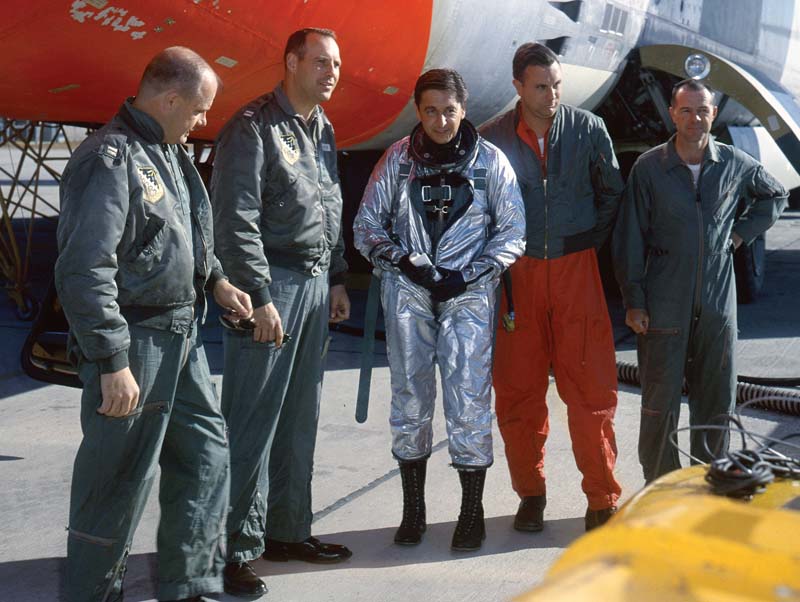
NAA test pilot Scott Crossfield made the initial X-15 flights, thus paving the pathway ahead for the others that followed. Clad in a full pressure suit sans helmet, and properly sized to fit in the claustrophobic X-15 cockpit, Crossfield poses with the flight crew of the NB-52 that carried him and the X-15 aloft. (Photo courtesy of Boeing Archives)
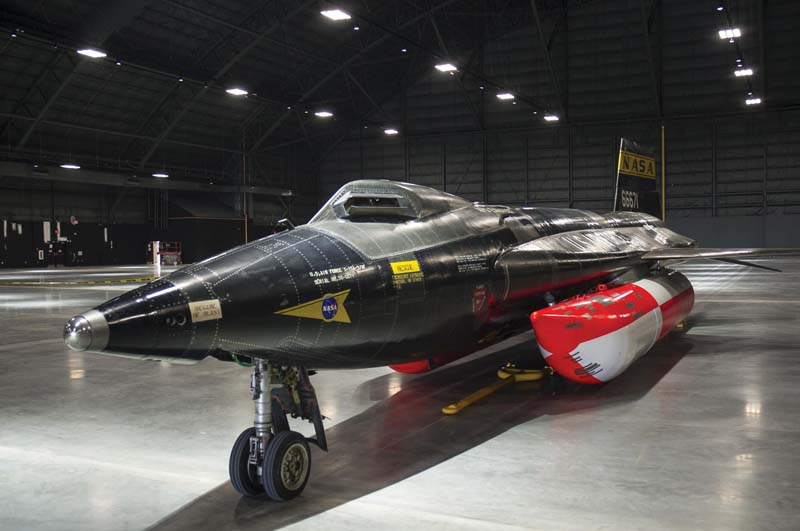
North American X-15A-2 on display in the Space Gallery at the National Museum of the United States Air Force. (Photo by Ken LaRock, courtesy of USAF)
Innovative controls
Multiple sets of controls were available to the solo pilot. Within the atmosphere, the choice was a side stick (similar to a modern jet fighter aircraft) or the convention central control stick. Since the X-15 also operated beyond the atmosphere, separate controls and thrusters were installed for use above 170,000 feet. Generating 40 pounds of thrust, there were two steam generators in each wingtip. Overall stability was provided by a Westinghouse Stability Augmentation System (SAS) utilizing gyros and controlling all three axes: pitch, roll, and yaw.
Especially innovative was a nose-installed metal ball (6.5 inches in diameter) with holes. Engineers use the letter “Q” in formulas to represent pressure. The “Q-ball” was used in lieu of pitot tubes to measure angle of attack and pressure. The inertial guidance system was furnished by the Sperry Gyroscope Company. The instrumented information provided included altitude, critical attitude, velocity, and distance. In common with the AGM-28 Hound Dog missile, the navigational system was celestial and made its way onto the Apollo lunar program. The control and re-entry systems evolved for integration into the Space Shuttle.
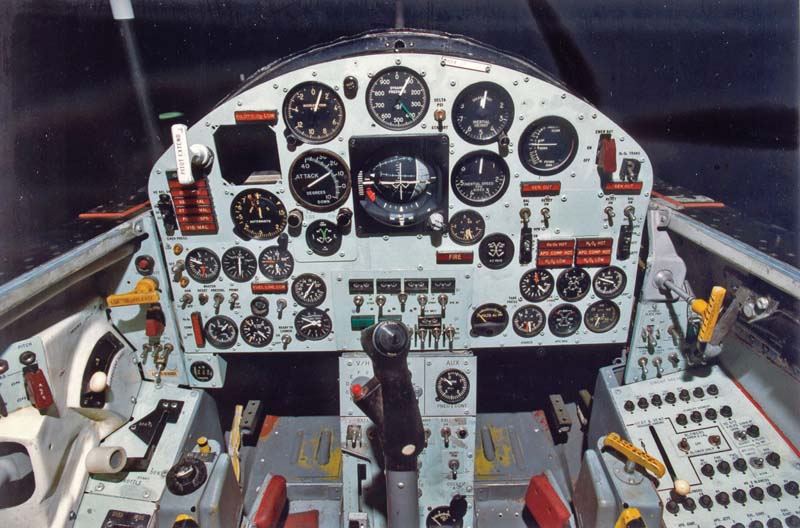
North American X-15A-2 cockpit at the National Museum of the United States Air Force. (Photo courtesy USAF)
The mothership
A search for a suitable mothership was undertaken. The precedent of launching X-planes from a bomber was cemented with the series of Bell X-1 drops from a B-29 in 1947. For the X-15 mission, the first heavy bomber evaluated was the Convair B-36 Peacemaker. It was disqualified because of approaching obsolescence and the vertical clearance within the bomb bay was inadequate.
The Boeing B-52 is a novel airplane with flexible wings that droop when at rest, eight engines, and a unique bicycle landing gear. Lacking thrust reversers, it relies on a drag chute to assist the brakes upon landing. So flexible are the wings that most versions were built without ailerons. These rely upon spoilers for banking or to maintain level flight. B-52 wing spars pass above the bomb bay making it a high-winged aircraft and leaving plenty of space below to easily fit an X-15. Furthermore, the B-52 was faster and flew higher than the B-36. Fully fueled and flight ready, the X-15 weighs 31,275 pounds—nearly the exact weight of a World War II-era B-25 Mitchell bomber also at maximum gross weight. Newer B-52s routinely carried conventional bomb loads of 60,000 pounds during the Vietnam War increasing to 70,000 pounds thereafter.
Sturdy structure (called “hard points”) suitable for attaching the X-15 were already built into every BUFF (a longstanding acronym for the “Big Ugly Fat Fellow”). Thus, it was determined the B-52 would be the perfect X-15 launch platform. With minimal fuel, the eight-engine Stratofortress was well-suited to make the climb to 45,000 feet at 500 knots with enough rudder and tail surface to easily offset the asymmetric drag of both the attached pylon and X-15 payload.
Two of the earliest B-52s off the Seattle assembly line, the third and eighth units, were culled from the flight test fleet in 1957 and dispatched to Palmdale, where they underwent drastic surgery that would forever render them unfit for wartime service. But otherwise, life was good for them. The climate was dry, missions were short, fuel loads light, and they were pampered by the best pilots and crew chiefs. Number 52-008 (known as “Balls 8”) served as a drop airplane until retirement in 2004. At age 50, it was then the oldest operational B-52 in the inventory but had the lowest flight hours.
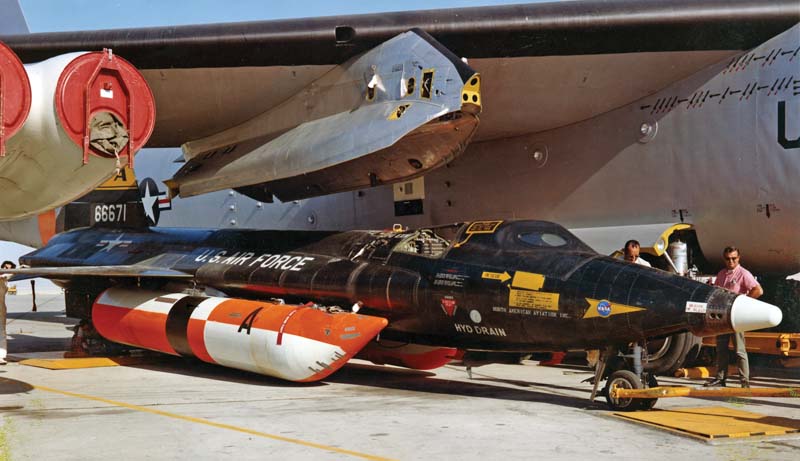
The second X-15 rocket plane (56-6671) is shown with two external fuel tanks which were added during its conversion to the X-15A-2 configuration in the mid-1960’s. (Photo courtesy of USAF)
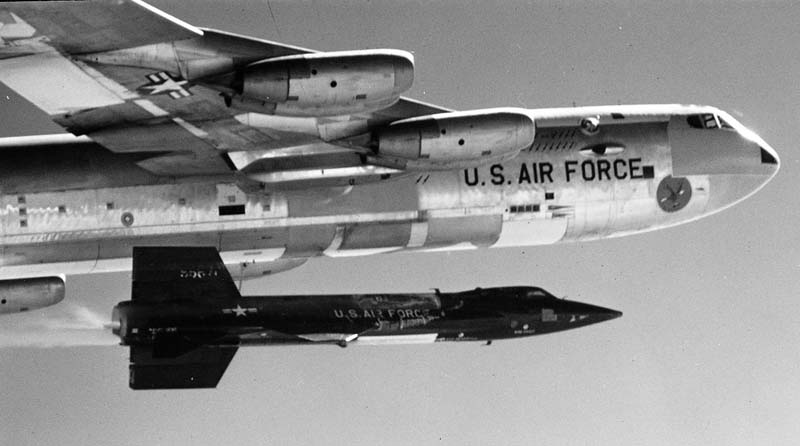
An X-15 launches from the NB-52 mothership. The X-15, fully loaded, weighs about 31,000 pounds—the same as a combat-ready World War II B-25 Mitchell medium bomber. A B-52D assigned to the Vietnam War normally carried a 60,000-pound load of bombs on missions starting in Guam (eight hours each way). (Photo courtesy of Boeing Archives)
Flying the X-15
Taken aloft by a B-52, the X-15’s stubby wings created lift at low speed while the fuselage provided lift at higher speeds. The tail extended in four directions and was broad at the back. A nose wheel delivered limited steering on the ground and skids were used in lieu of main landing gear tires. The bottom part of the lower tail was jettisoned and parachuted to the ground before landing. Landing was accomplished on the Rogers Dry Lakebed at Edwards AFB, California. This runway, one of many at Edwards, is 12 miles long.

Much of the internal space of the X-15 was taken up by tanks and pressure vessels holding cryogenics. Expending nine tons of propellants in seconds while maintaining a near constant center of gravity throughout the entire flight envelope presented another design challenge; therefore, the liquid oxygen (LOX) and anhydrous ammonia tanks were placed on either side of the center of gravity. Control was maintained by expelling both liquids towards center of gravity.
The X-15 primary propulsion system was a rocket motor from Reaction Motors. The rocket engine was controlled by throttle with thrust ranging from 17,000 to 59,000 pounds. The fuel was LOX and anhydrous ammonia. Small rocket thrusting was needed to maneuver the X-15 when it was beyond sufficient Earth atmosphere. The twelve thrusters were powered by hydrogen peroxide. Four were in the wings while eight were in the nose.
As could be expected for the initial flights of a research aircraft, the payload consisted of 1,300 pounds of research instrumentation, involving approximately 600 temperature pickups and 140 pressure pickups. The program spanned ten years with 199 flights conducted. Of the 12 X-15 pilots, Scott Crossfield was on the NAA payroll. The others came from the Air Force, Navy, and NASA.
The first aircraft is on display in the main hall of the National Air & Space Museum, while the second airframe can be viewed at the National Museum of the Air Force near Dayton, Ohio. The third X-15 was lost on the aircraft’s 65th mission. After achieving an altitude of 266,000 feet at a speed of Mach 5.2, it skewed off its flight path and went into a spin followed by a dive. Forces measured at +/- 15 G were encountered and the aircraft disintegrated. The pilot, Major Michael J. Adams, USAF, was also lost.
With the data gleaned from the X-15 missions, the US was on its way to the moon and the groundwork had been laid for the Space Shuttle.
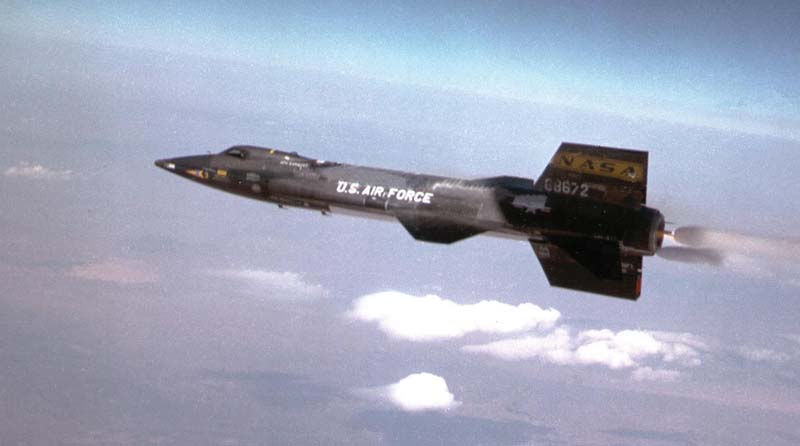
An X-15 jet flying in the upper atmosphere
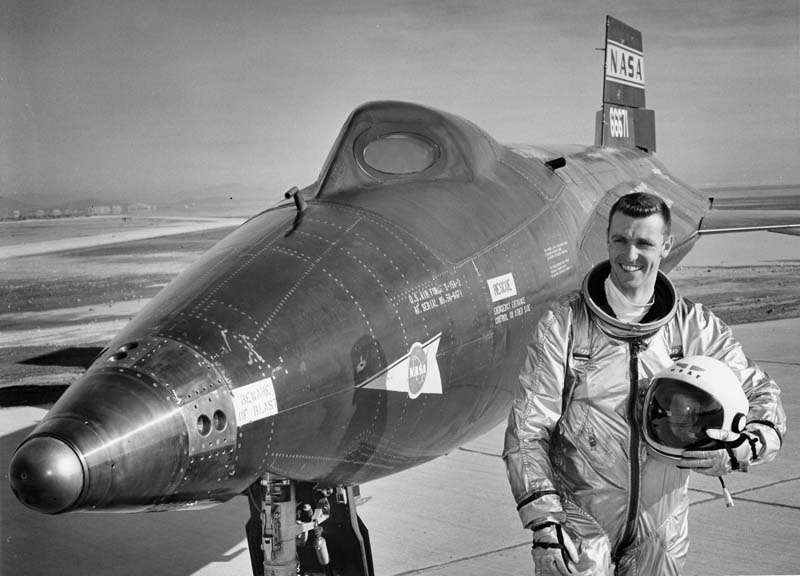
Astronaut Joe H. Engle and the North American X-15A-2. (Photo courtesy of USAF)
Tug of War at a Crashed X-15
On November 5, 1959 an engine bay fire erupted on Scott Crossfield’s fourth X-15 flight after one of the rocket chambers exploded. Scott shut down the engine and began jettisoning propellants while setting up for an emergency landing on the Rosamond Dry Lakebed. Due to the steep nose-down attitude during the landing approach, there was insufficient time for Crossfield to jettison all the propellants. He touched down at a low speed in a nose-high attitude with a considerable fuel load still in the tanks. The fuselage buckled just behind the cockpit when the nose slammed down. Three-quarters of the bolts securing the fuselage at the break point sheered. The airplane slid to a stop on its nose gear, belly, and main gear skids. It was not his best landing; fortunately, Crossfield’s only injury was to his pride.
Crossfield often told the story of his tug-of-war with the flight surgeon after the aircraft came to a stop. The flight surgeon aboard the rescue helicopter overheard someone say something about a broken back. The comment referred to the aircraft, but the doctor assumed that Scott Crossfield’s back was fractured because of the crash landing. When the rescue helicopter landed next to the X-15, the flight surgeon jumped out with a backboard and ran up the X-15 cockpit to rescue Crossfield from the damaged aircraft. Scott had partially opened the canopy in preparation for a hasty evacuation. The flight surgeon decided that he had to get the canopy out of the way to get the backboard on Crossfield before moving him from the cockpit. The physician pushed the canopy up to open it further.
When Crossfield realized what the flight surgeon was doing, he grabbed onto the canopy in a desperate attempt to hold it down since he knew that excessive canopy motion would arm the ejection seat. He did not want to be ejected accidently after surviving an explosion, fire, and an emergency landing. Crossfield could not talk to the flight surgeon since his faceplate was still closed. The adrenaline-fueled struggle continued: one pushing, the other pulling on the canopy, both attempting to save Scott’s life. After a minute of two of this Herculean effort, the flight surgeon finally gave up. He rationalized that Crossfield could not be seriously injured if he had strength to pull that hard on the canopy.
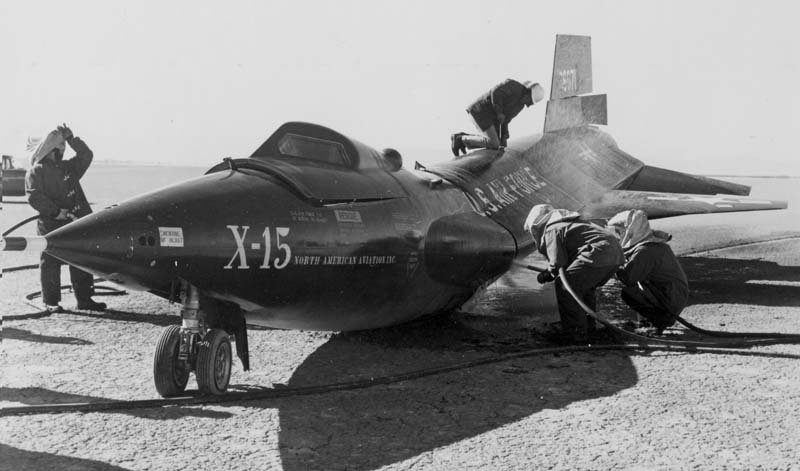
Scott Crossfield was forced to land the X-15 fast and heavy on November 5, 1959 when an engine failed. The weight of propellant still on board broke the fuselage. A tug of war with a flight surgeon ensued. (Photo courtesy of Dennis Jenkins)
By John Fredrickson

















What a great story ! Scott Crossfield has been my hero since I was a boy reading about his exploits in elementary school. He certainly earned every bit of my hero-worship.
I have always believed that the X-15 program sent us on our way to space and still do. I also believe our government decided to pull monies from our development into space which put us behind.
Very clear and interesant lecture